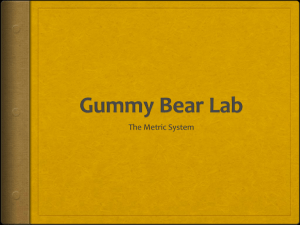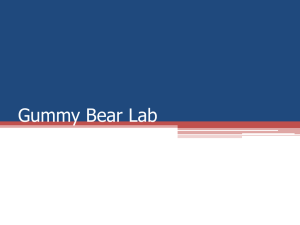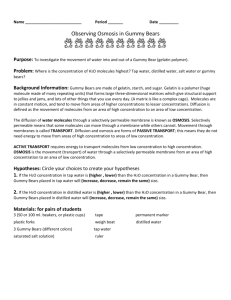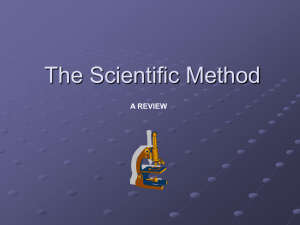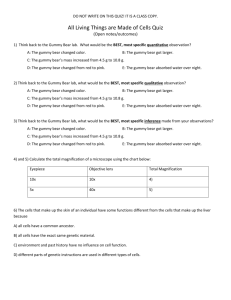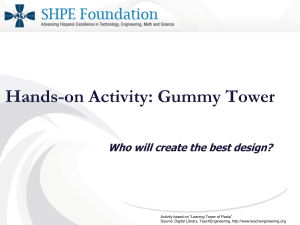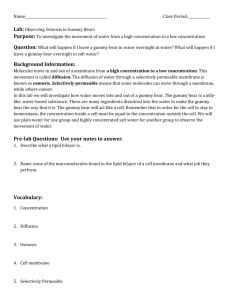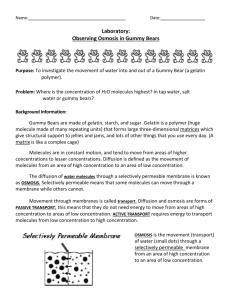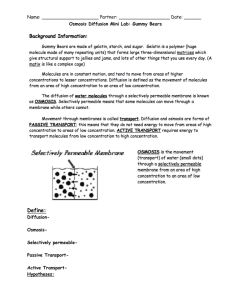“Gummy Bear” Lab - mrs. villarreal`s orange team science
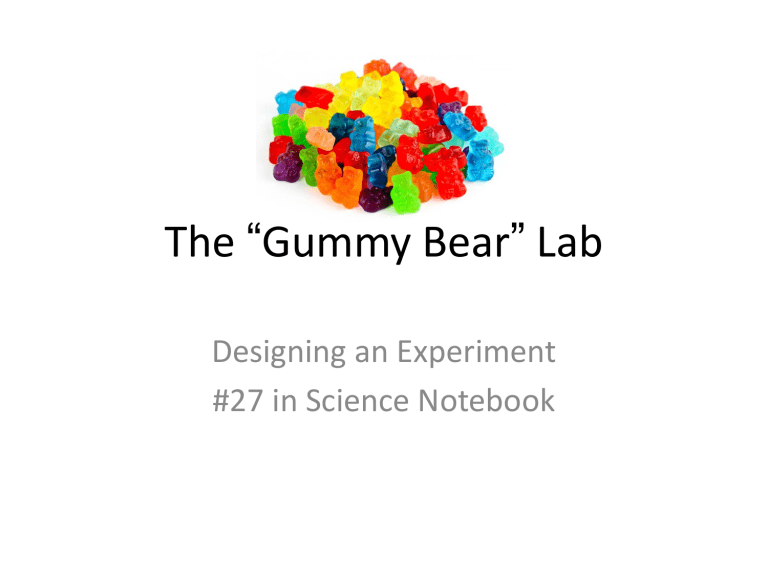
The “ Gummy Bear ” Lab
Designing an Experiment
#27 in Science Notebook
OVERVIEW
PURPOSE
• The MAIN GOAL of this week is to review the guidelines for designing an experiment in preparation for 8
th
grade.
• This will be your last FORMAL lab report of the school year and last
major assignment of the year.
OVERVIEW
• TODAY: Each team will measure the mass, volume, and density of their gummy bear. Students will write a hypothesis and soak their gummy bear in water overnight.
• TOMORROW: Re-measure wet gummy bear and determine if hypothesis was correct. Choose manipulated variable, writes hypothesis & create materials list.
• MONDAY: Each team writes their own detailed procedures to test their variable.
• TUESDAY: Each team sets up their experiment, creates data tables, and draws diagrams. Soak gummy bears.
• WEDNESDAY: Make observations, take measurements, and write conclusion.
• FRIDAY: Lab is due. Students will be graded individually.
Formal Lab Report
• Title (“The effect of _______ on gummy bear volume.”)
• Introduction
• Hypothesis (“If ____, then _____”)
• Materials (bulleted list)
• Procedures (numbered list)
• Results (data table)
• Conclusion (paragraph)
DAY ONE
Wed May 7
Day One- Hypothesis
• What do you think will happen to a gummy bear when you put it in water overnight?
• If I soak a gummy bear in 40mL of water over night, then the color will __________, the volume will _________, and the mass will
____________.
Day One- Measurements
1
In pairs, you will make both qualitative and quantitative observations of your bear…
Day Bear
Color
Length
(mm)
Width
(mm)
Thickness
(mm)
Volume
(mm3)
Mass
(g)
Density
)
(g/mm3
2
Amount of
Change
What do you think will happen to a gummy bear when you put it in water overnight?
Day One- Measurements
• Length (mm)- top of head to bottom of feet
• Width (mm)- Widest point across back of bear
• Thickness (mm)- from front to back at thickest point
• Volume (mm3)- multiply length, width, and thickness
• Mass (g)- Use triple beam balance. Round to nearest tenth of a gram.
• Density (g/mm3)- mass / volume. Round answer to nearest hundredth.
DAY TWO
Thurs May 8
Day Two
• In pairs, you will re-measure your bear and note any changes in the past 24 hours.
• Answer questions 1-4 on your paper.
Day Two
• Questions:
– 1.) Was your hypothesis correct? Why or why not?
– 2.) Which change is greater- volume or mass?
Explain.
– 3.) Was there a change in density? Why?
– 4.) How do your results compare to those of your classmates?
Let’s design our own experiments!
Choosing a Variable
Title
TITLE
•
Manipulated Responding
The effect of __________ on __________.
• Manipulated Variable: is what is being CHANGED.
• Responding Variable: responds to what is being manipulated. It is what you are MEASURING.
• INDIVIDUALLY, BRAINSTORM A LIST OF POTENTIAL
MANIPULATED VARIABLES!
• WITH YOUR PARTNER(S), CHOOSE AN MANIPULATED
VARIABLE.
• WRITE YOUR TITLE!
INTRODUCTION
• Purpose of Lab (Paragraph)
– “The purpose of this lab is to determine the effect of
– PLEASE WRITE YOUR INTRODUCTION.
– Explain WHY the information learned in this lab might be useful
– Explain WHO this information might benefit.
– PLEASE WRITE THE NEXT TWO SENTENCES.
INTRODUCTION (continued)
• Hypothesis.
How will manipulated How will this affect
– If ____________, then____________.
– Example: If ________________,
– then ________________.
• PLEASE WRITE YOUR OWN HYPOTHESIS
(INDIVIDUALLY).
DAY THREE
MATERIALS
Bulleted list of ALL materials used INCLUDES…
-Size of each (medium paper clip)
-Number of each (2 medium paper clips)
Formal Lab Report
• Title
• Introduction
• Hypothesis
• Materials
• Procedures
• Results
• Conclusion
TODAY!
PROCEDURES
• The purpose of writing methods is so that somebody could RECREATE your experiment.
• Written in NUMBERED, COMPLETE sentences.
• Includes MEASUREMENTS.
DIAGRAM
• Visual representation of equipment setup.
• Demonstrates understanding of experiment.
• Must be labeled with arrows.
• Stick figures are fine.
Some examples and NON examples to give you an idea of what I ’ m looking for …
Quite possibly the worst procedures ever written:
– Build a parachute.
– Measure its decent time.
Bad Bad Bad (included materials, but not amounts):
• 1. Using a trashbag, thread, tape, and scissors, build a parachute.
• 2. Measure its decent time using a stopwatch.
Still not good (included material amounts, but not specific enough instructions):
• 1. Tape eight pieces of 35cm thread to the outside of a trashbag circle with a diameter of 23cm.
• 2. Hang two jumbo paper clips from the knot at the bottom of the strings.
• 3. Measure its descent time from ceiling to floor using a stopwatch five times. Calculate average.
Great!
• 1. Using scissors, cut a circle with a 23cm diameter out of a large white trashbag.
• 2. Using scissors, cut eight pieces of thread, each 35cm long.
• 3. Tape the ends of each piece of thread, equally distributed, around the outside of the trashbag circle using eight pieces of scotch tape, each 3cm long.
• 4. Holding the bag & thread from the top like a jelly fish, gather the un-taped ends of the thread together, and gently twist and tie in knot.
• 5. Hang two jumbo paper clips from the knot.
• 6. Have one person standing on top of a chair holding the parachute so that the top is touching the ceiling, and another standing on the ground holding a stopwatch. A third person, if available may stand on ground, holding data table ready to record data.
• 7. Use the stopwatch to determine how long it takes the parachute to fall from the ceiling to the floor, without hitting anything on the way down. Record the data in seconds into the data table.
• 8. Repeat until you have five clean falls, making note of how many times it took you to get five clean falls.
• 9. To calculate the average of the five descent times: add the numbers together, and divide by five. Include that number in your data table.
DAY FOUR
Today you will…
• Finish writing detailed, numbered procedures
• Create a labeled diagram of all three cups
• Draw THREE data tables, one for each cup.
• Obtain 3 gummy bears and follow your own instructions to measure their “Day 1” info.
Enter the data into your three data tables.
• Set up your cups and begin soaking your bears.
DAY FIVE
Checklist for today…
• 1.) Finish writing detailed, numbered procedures.
• 2.) Draw a labeled diagram of all three cups.
• 3.) Create 3 data tables, one for each cup.
• 4.) Measure length, width, thickness, volume, mass, and density of 3 DRY gummy bears. (“Day 1” row)
• 5.) Set up your 3 cups according to your procedures.
• 6.) Soak gummy bears overnight.
• 7.) Measure length, width, thickness, volume, mass, and density of 3 WET gummy bears. (“Day 2” row)
• 8.) Calculate amount of change for each bear (third row)
• 9.) Write conclusion paragraph.
DAY SIX
Checklist for today…
• 1.) Finish writing detailed, numbered procedures.
• 2.) Draw a labeled diagram of all three cups.
• 3.) Create 3 data tables, one for each cup.
• 4.) Measure length, width, thickness, volume, mass, and density of 3 DRY gummy bears. (“Day 1” row)
• 5.) Set up your 3 cups according to your procedures.
• 6.) Soak gummy bears overnight.
• 7.) Measure length, width, thickness, volume, mass, and density of 3 WET gummy bears. (“Day 2” row)
• 8.) Calculate amount of change for each bear (third row)
• 9.) Write conclusion paragraph.
Formal Lab Report
• Title
• Introduction
• Hypothesis
• Materials
• Procedures
• Results
• Conclusion TODAY!
CONCLUSION
• What were you testing?
• What were your variables?
• Was your hypothesis correct? Why or why not? How do you know? (GIVE DATA!)
• List at least three sources of error (ways that you messed up) and how to fix them in the future
• List 2 questions that you still have about your gummy bears.
Formatting = 10pts
• As with all assignments, write your name, date, and period in the upper right hand corner. (4 pts)
• TYPE or handwrite neatly with INK. Rough drafts will not be accepted. (1pt)
• Separate by section- and label each section! (2 pts)
• Double check your spelling and grammar.
(Remember: deSCent, not decent!) (3 pts)
